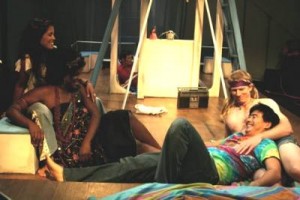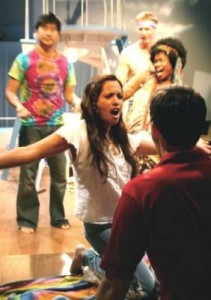
The year is 1974 and a quintet of Tufts University friends have gone whale watching off the coast of Provincetown. Virginal conservative gay guy Val and liberal lesbian Jan are arguing about politics, Val contending to Jan’s absolute horror that “you can’t blame Nixon for Kent State.” Blond Adonis Sunny is stoned as usual, and arguing with feisty lesbian Elle on whether it’s TLGC (Tufts Lesbian and Gay Community) or TGLC, alphabetical order making more sense to Sunny as a gay male. Completing the fivesome is Sunny’s devout Catholic boyfriend Gene.
These are the characters whose lives we will follow over the course of 25 years in Nick Salamone’s compelling new drama Sea Change, just opened at the L.A. Gay and Lesbian Center’s Davidson/Valentini Theatre.
We soon learn more about the quintet, for example that Jan believes that she can see things, like Cassandra, that Gene loves memorizing and reciting Auden (he says he has a verse for every season), that Sunny and Gene have been a couple since they met two years ago, and that Val and Elle have been friends since childhood.
Elle recommends a few tokes of pot to help Val with his seasickness and his shyness (“It’s better than Dramamine I tell you”), and soon all five are high, dancing to the strains of “Rock The Boat,” and getting to know each other better. Elle and Jan share a passionate kiss, a surprise to Elle who’d previously thought Jan to be a fag hag. Meanwhile, Sunny is so pissed off to learn that Gene is thinking of entering a Catholic seminary (and that Val knew about this first) that he strips butt naked. (No audience complaints here.) “How could you give us up so early?” he demands in fury and wants nothing to do with a boyfriend who vows to “change the church from within.”
Following Sunny’s example, Elle goes topless, Jan gets down to her birthday suit as does Val, though in Val’s case, his clothes have to be forcibly pulled off him. (“This is just like Rosemary’s Baby!” he screams.) Shy future priest Gene keeps on his green briefs, telling Sunny, “I’m saving this for you … later.”
Then, suddenly the five nude and seminude friends catch sight of a whale and there is a flash of light and the sound of a camera lens opening and shutting.
The action moves forward 21 years, to 1995. Lives and relationships have changed, and one of the friends is dying of AIDS. Act 2 moves the story forward to 2000 with the four surviving friends about to welcome a baby into their midst, even as a long-term couple decide to call it quits and two longtime friends contemplate becoming more than just friends.
Director Jon Lawrence Rivera is one of Los Angeles’ finest directors, and his work has never been better than in Sea Change. Working with a superb group of actors and a stunning design team (the audience surrounds Gary Lee Reed’s amazingly real boat, becoming part of the friends’ voyages), Rivera brings Salamone’s script to vivid yet sensitive life.
Salamone has written a complex multi-leveled script which deals with friendship, faith, commitment, serodiscordant couples, gay parenting, second chances, and the metaphysical. (I must admit to the latter being the one element in Salamone’s script that I found myself tuning out to, not being able to make much sense of talk about Proteus and pagans or lines like “Are you my familiar?”)
The cast assembled for Sea Change could not be better. Nick Cimiluca, in a 180 degree turn from his war-scarred Viet Nam soldier in Tracers, reveals depths hidden below Sunny’s spaced-out surface, and the caring friend and lover Sunny is capable of being. Ryun Yu, recently cited by StageSceneLA for his Dramatic Performance Of The Year in Dawn’s Light: The Journey Of Gordon Hirabayashi, continues to prove himself one of the finest young actors around. As Gene faces his own mortality, Yu’s performance is as much internal as in the words he speaks, his eyes revealing volumes. Clay Storseth is pitch perfect as Val, painting a very real portrait of a man caught between the desire to embrace his gay self and deep-seated fears of sex and intimacy. Fran De Leon’s performance as Elle is so “in the moment” that you can’t take your eyes off her, and as the years pass and Elle becomes more and more her own woman, so does De Leon’s work just keep getting better and stronger. Finally, there is the breathtaking performance of Lisa Tharps as Jan, arguably the play’s most complex character, who faces not only the loss of her dearest friend but also the demons of schizophrenia. As with Yu, the depth of Tharps’ performance can be read in her expressiveness of her eyes, and when tears well up in hers, the emotion is contagious.
Sea Change has some of the most effective lighting I’ve seen in a dramatic play; when several things are happening at once on stage, Tim Guion’s lighting design oh so subtly directs your attention to the playwright’s focal point, all the while allowing you to continue to observe what other characters are doing. Elizabeth Huffman’s costumes and an uncredited wig designer deserve high marks for their choice of costumes and hair styles which fit both era and character. Bob Blackburn’s sound design features sounds of the sea and a perfectly chosen selection of music (including The Hues Corporation’s “Rock The Boat,” Seal’s “Kiss From A Rose,” and, most powerfully, Joni Mitchell’s 2000 re-recording of “Both Sides Now”).
It is good news indeed that the Gay & Lesbian Center is offering Los Angeles’ vibrant gay and lesbian theatergoing audience another venue for plays of special interest to the LGBT (GLBT?) community. It is unusual to find a play of equal interest to both gay men and women. Luckily for all, Sea Change is just such a play, well worth seeing, and sure to provoke much discussion both at intermission and after lights have gone down on its dramatic final tableau.
Davidson/Valentini Theatre, the Village at Ed Gould Plaza, 1125 N. McCadden Place, Los Angeles.
–Steven Stanley
September 22, 2008




 Since 2007, Steven Stanley's StageSceneLA.com has spotlighted the best in Southern California theater via reviews, interviews, and its annual StageSceneLA Scenies.
Since 2007, Steven Stanley's StageSceneLA.com has spotlighted the best in Southern California theater via reviews, interviews, and its annual StageSceneLA Scenies.







 COPYRIGHT 2024 STEVEN STANLEY :: DESIGN BY
COPYRIGHT 2024 STEVEN STANLEY :: DESIGN BY